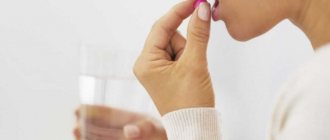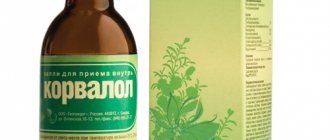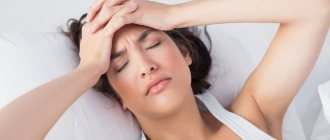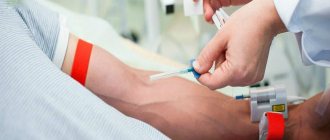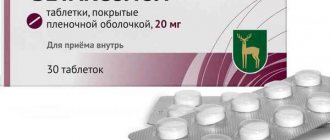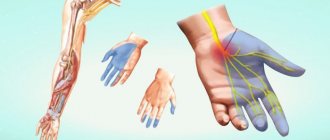Increased intraocular pressure can be temporary or permanent. In the first case, the problem lies in physical and mental overload or stress. However, after rest, ophthalmotonus mostly returns to normal. If the pressure is constant, then glaucoma gradually develops. It mainly occurs in mature people after 45 years of age due to hormonal imbalances and heart and kidney diseases.
You can determine ophthalmotonus using the following methods:
- Pneumotonometry. A stream of air is directed onto the eye. The final result is displayed on the device display.
- Tonometry. A weight painted with harmless paint is placed on the surface of the eyeball. Due to its weight, it is pressed in and leaves a mark, the brightness of which is used to estimate the pressure.
Focusing on the distinctive signs, namely dryness, burning and pain in the eyes, anyone can suspect that they have high ophthalmotonus. You can test it at home and you don’t need to buy anything. Just close your eyelids and apply light pressure with your finger. The results could be like this:
- An elastic eyeball, slightly pressed inward, indicates that everything is normal.
- A hard eyeball that does not move is a sign of high blood pressure.
- A soft eyeball, easily pressed, most often indicates low ophthalmotonus.
Normal indicators
Experts say that the ophthalmotonus of an adult should not be less than 10 mmHg. Art. The upper limit of normal eye pressure is 23 mmHg. Art. If the indicator does not deviate upward or downward, the required level of microcirculatory and metabolic processes is maintained. In addition, the normal condition of the retina is maintained.
It is important to know that eye pressure may change during the day. In this regard, ophthalmologists recommend keeping an observation diary for at least several days. This will help make an accurate diagnosis. You also need to know that the difference in morning and evening measurements should not be more than 3 mm Hg. Art.
If the pressure has increased slightly (up to 25 mm Hg), the doctor may suspect the development of glaucoma. In this case, a comprehensive diagnosis is required. Indicator from 25 to 27 mm Hg. Art. speaks of the initial stage of development of glaucoma. If the value is 27-30 mmHg. Art., this indicates the rapid development of pathology. If there is an indicator of 30 mm Hg. Art. and it is more common to talk about severe glaucoma.
In stores specializing in the sale of medical equipment, you can purchase a device for home eye pressure measurement. Its cost ranges from 2,000 rubles to several tens of thousands of rubles, depending on the model.
Reasons for the increase
There are a huge number of them. That is why during an appointment, ophthalmologists very carefully collect and analyze data from the patient’s medical history.
The main provoking factors are the following:
- Pathologies of the cardiovascular system (atherosclerosis, thrombophlebitis, varicose veins, arrhythmia, myocardial damage, etc.).
- Vegetovascular dystonia.
- Diabetes.
- Diencephalic syndrome (most often occurs after a traumatic brain injury).
- Kidney damage.
- Intoxication caused by chemical compounds.
- Frequent and prolonged work at the computer.
Persons who are at risk for these reasons are recommended to visit an ophthalmologist at least once a year. The specialist will conduct an examination and, if necessary, tell you what to do if you have eye pressure.
Clinical picture
Against the background of increased ophthalmotonus, a person experiences severe discomfort. Main symptoms of high eye pressure:
- Constant fatigue. It occurs even at rest.
- Frequent headaches that are very difficult to relieve with medication.
- Redness of the sclera of the eyes for no apparent reason.
- A feeling of pressure in the area of the eyebrows and temples, usually occurring in the evening hours.
- Poor vision at night or in dimly lit rooms.
- When looking at some bright light source, a rainbow halo appears.
Another sign of the disease is hardening of the eyeball. But this can only be determined by an ophthalmologist during an appointment.
How to reduce intraocular pressure
Treatment of IOP is directly dependent on the period of formation of hypertension. If problems have recently begun to appear and no significant pathologies in the functioning of the eyes have yet been traced, fairly basic methods will help:
- regular blood pressure measurement;
- gymnastics for the eyes;
- wearing specialized safety glasses;
- ophthalmic moisturizers;
- control of time spent on a PC or watching TV.
Thus, you can significantly reduce eye strain and quickly relieve inflammation. In the arsenal of ophthalmologists today there are 2 effective methods that help solve the problem:
- Laser dissection of the iris;
- Trabecular stretching with laser.
These techniques make it possible to improve the removal of unnecessary secretion products, reducing the pressure inside the eye. When the disease is at an advanced stage and signs of glaucoma appear, when pain in the eyeball is increasingly felt, medical science is helpless to stop the regressive movements. But observation by an ophthalmologist and strict adherence to the instructions will provide an opportunity to avoid further decrease in vision.
Conservative treatment
It is unacceptable to prescribe medications on your own. The advisability of using a particular drug should only be assessed by a doctor, especially for glaucoma.
Eye pressure can be reduced in several ways. They are described in the table below.
| Way | Decoding |
| Eye drops | For increased intraocular pressure, ophthalmologists prescribe the following medications:
It is important to know that more than two drugs cannot be used at the same time |
| Pills | They help with eye pressure worse than drops. However, an ophthalmologist may consider it advisable to take them. The most commonly prescribed tablets for eye pressure are: “Anaprilin”, “Hypothiazide”, “Proserin”, “Clonidine”, “Cavinton” |
| Physiotherapy | Allows you to preserve visual functions for a longer time. As a rule, doctors prescribe the following physiotherapeutic methods:
|
| Surgery | Currently, patients are prescribed one of two methods of surgical treatment: goniotomy or trabeculotomy. These treatment methods are both radical and modern. The choice of method is made exclusively by the doctor. Initially, the specialist assesses how far the patient’s eye pressure deviates from the norm, then finds out whether there are any complications |
| Laser treatment | After the procedure, less intraocular fluid is produced. During the operation, the doctor opens the outflow pathways. Due to this, a persistent decrease in eye pressure is achieved. |
It is important to understand that if an increase in ophthalmotonus is a consequence of the progression of a disease, it is necessary to get rid of the root cause.
Pills
This form of drug treatment is rarely used. Taking tablets showed the least effectiveness in reducing IOP compared to other drugs.
It is possible to remove ophthalmotonus with their help, but it will take more time. If you need quick results, use eye drops. Unlike tablets, they do not affect the stomach and intestines. The drops bypass the digestive tract, thereby causing less harm and causing virtually no side effects.
Acetazolamide is used to reduce ocular hypertension. The dosage, frequency of use and duration of treatment are determined by the attending physician after a thorough diagnosis of the patient’s visual system.
Brinzolamide suspension is also prescribed. The drug is also an inhibitor. The ophthalmic suspension is absorbed to some extent systemically.
Folk remedies used externally
Treatment with alternative methods is not only accessible and effective, but also safe. Of course, if a symptom bothers you very often, you need to see a doctor as soon as possible. But even in this case, as part of first aid, you can reduce eye pressure without medications.
As practice shows, lotions are highly effective. The most effective are the following recipes:
- Take nettle and lily of the valley leaves. Grind the raw materials thoroughly. Take half a glass of nettle leaves and 1 tsp. lily of the valley Mix the ingredients. Add 5 ml of water to the resulting slurry. Apply the finished product in the form of a compress to the eyes.
- Cut off a few aloe leaves. It is desirable that they be meaty. Fill a small saucepan with water and put it on the fire. Boil. Then dip the aloe leaves into the water. Cook for 2 minutes. Remove the softened leaves, place them in a gauze cloth and squeeze out the juice into a clean container. Mix the latter with the broth in a 1:1 ratio. Cool. Use the resulting product as eye drops. Immediately after instillation, a tingling sensation may appear.
- Boil a chicken egg. Peel it and cut it into 2 halves. Remove the yolk. Place the whites on your closed eyes. Leave them until they cool completely.
- Mix clean water and honey in equal proportions. Soak cotton pads in the resulting liquid and apply them to your eyes for 40 minutes.
- Take one medium-sized potato, wash it, peel it and chop it using a grater. Add 5 ml of apple cider vinegar to the resulting mass. Then this mixture must be wrapped in gauze and applied to the eyes. Ideally, part of the forehead will also be covered.
- Take a few dandelion leaves and flowers. Wash, dry and grind the raw materials to a powder state. Then dandelion must be mixed with honey in equal proportions. Apply the resulting ointment to your eyes 5-6 times a day.
- Take a small onion. Grind it using a blender. Wrap the resulting pulp in gauze and squeeze the juice into a clean container. Mix the healing liquid in equal proportions with honey. Apply the resulting product to your eyes. You can use such a liquid only if there is no tendency to have an allergic reaction.
According to reviews, after the first procedure, intraocular pressure decreases. The duration of treatment for persistent high ophthalmotonus should not be less than 20 days.
Recipes for oral products
It is important to understand that any natural component is a potential allergen. If signs of an undesirable reaction occur, it is recommended to stop alternative treatment for eye pressure. If unpleasant symptoms do not disappear, it is recommended to consult a doctor.
How to relieve eye pressure at home:
- Take coriander and anise in equal proportions. The raw materials must first be dried and crushed. Mix the ingredients and pour 300 ml of boiling water over them. Let it brew for 3-4 hours. Strain. Drink the healing liquid in one go. The next day you need to prepare a new infusion.
- Take 1 liter of woodweed juice and 100 ml of vodka that does not contain foreign additives. Mix both components in a glass jar. Close the container and place it in a dark place with cool air. Let it brew for 5 days. Take the resulting product twice a day, 50 ml. This liquid has an extremely unpleasant specific taste, and therefore it is recommended to drink it with water.
- Take a few currant and rowan leaves. Rinse the raw materials under running water. Place the leaves in a mug and pour boiling water over them. Let it brew for 10 minutes. The resulting drink can be drunk instead of tea several times a day.
- Take nettle leaves, sleep grass and several shoots of wild pear. Wash and grind the raw materials. Place all components in one container and pour 250 ml of boiling water over them. Let it brew for half an hour. Divide the liquid into 3 doses. Consume before meals.
- Take a handful of dill seeds and grind them using a blender. Pour the resulting raw material into 300 ml of boiling water. Let it brew for 2 hours. Divide the prepared liquid into 4 doses.
- Take oak bark. Grind the raw materials. Pour 200 ml of boiling water over it. Let it brew for 3 hours. Take the resulting liquid in the morning immediately after waking up (on an empty stomach).
- Take 200 g of fresh blueberries. Grind the berries using a blender. Mix blueberries and honey in equal proportions. Take the resulting product 4 times a day, 3 tbsp. l. The mixture must be stored in the refrigerator.
- Take cinnamon, motherwort, licorice root, buckwheat, ginger, and lemon balm in equal proportions. Wash and grind the raw materials. Mix all ingredients thoroughly. Take 2 tbsp. l. the resulting collection and pour 500 ml of boiling water over it. Let it brew for 2 hours. Strain. Take the infusion three times a day, half an hour before meals.
- Pour clean water into a glass. Dilute 0.2 g of mumiyo in it. Take the resulting product before each meal and before bedtime.
- Take dry corn silk (they can be purchased at any pharmacy). Pour 250 ml boiling water 1 tbsp. l. raw materials. Let it brew for 40 minutes. Strain. Take 50 ml infusion three times a day 15 minutes before meals.
Traditional treatment can be perfectly combined with medication. According to medical reviews, the effect of combination therapy occurs faster.
Herbal collection
Reviews from many ophthalmologists say that an excellent remedy for reducing eye pressure is a decoction made from a herbal mixture.
To create this collection, you need to take several types of dried herbs in equal proportions. It must include yarrow leaves, mistletoe, horsetail, and periwinkle inflorescences. The components must be mixed thoroughly.
Fill a spoonful of the prepared mixture with a glass of boiling water and, adding a few dry or fresh hawthorn fruits to the total mass, close the lid tightly. In this form, the mixture should be placed in a water bath and simmered for 10-15 minutes. After the specified time, the mass must be cooled and then strained. The decoction prepared in this way is enough for exactly a day - it is recommended to use it twice, half a glass each.
Gymnastics
Simple eye exercises can help lower your blood pressure. During gymnastics, blood circulation in the organs of vision significantly improves, due to which uncomfortable sensations recede.
How to relieve eye pressure at home or any other:
- Open your eyes wide, then close your eyes as tightly as possible. Do 10 repetitions.
- Blink intensely for 2 minutes.
- Move the eyeballs to the left. Count down 15 seconds. Then move your eyes to the right. Also hold at the maximum point for 15 seconds. Then make rotational movements with your eyeballs several times.
- Blink intensely for 1 minute. Rest for 10 seconds. Then blink for another 1 minute, but at an average pace.
- Concentrate your gaze on some object located nearby. Stare at it for a few seconds. Then move your gaze into the distance and concentrate your gaze on an object located far away. Do 10 repetitions.
- Close eyes. Mentally draw various geometric shapes with your visual organ.
It is necessary to perform eye exercises daily. It does not take much time, but at the same time, against the background of regular exercises, the functioning of the organ is normalized and the eye pressure indicator decreases.
Doctors' recommendations
Ophthalmologists argue that treatment will not be effective enough if patients do not follow a number of important rules. On the contrary, increased eye pressure will cease to bother you if you constantly perform them.
Doctors' recommendations:
- It is advisable to purchase a high pillow. During sleep, the head will be elevated, which will have a beneficial effect on eye pressure.
- It is necessary to properly organize the lighting in the room. Dim light is one of the main reasons for poor health.
- Perform eye exercises daily.
- In people suffering from high ophthalmotonus, eye pressure always increases in movie theaters. Therefore, it is recommended not to visit them.
- Do not wear clothes with tight collars. Or constantly walk around with the top button undone. Ignoring this recommendation leads to a deterioration in blood supply to the brain. This, in turn, negatively affects the condition of the visual organs.
- It is not advisable to bend over too much during physical activity.
- Avoid visual overload. If you have to spend most of the day at the computer, it is recommended to do simple eye exercises every hour.
- It is recommended to stop smoking and drinking alcohol. Against the background of bad habits, the blood supply to the brain and visual organs significantly deteriorates.
- We must not forget about the drinking regime. But it is not recommended to drink a lot of water. The norm is 1.5-2 liters of pure non-carbonated liquid per day.
- It is advisable to exclude salty foods and strong coffee from your diet. They provoke an increase in intraocular pressure.
- Avoid getting into stressful situations.
- Eat foods rich in vitamins and minerals as often as possible.
In addition, experts recommend taking a course of massage of the collar area twice a year.
General approach to lifestyle for the prevention of eye pressure
A temporary increase in IOP often occurs for the following reasons:
- alcohol abuse;
- excessive coffee consumption;
- with a strong cough;
- from non-stop vomiting;
- when lifting heavy weights.
During treatment, it is necessary to reduce the time you work with the computer, rest on a high, dense pillow, limit the consumption of alcohol, foods containing salt, coffee, and tea. Try to lower the level of insulin in the blood by refraining from consuming glucose, cereals, and starchy foods. Walk more outdoors and do light gymnastics.
But power or contact sports will need to be eliminated, at least temporarily, since constant overload and concussions will negate the results of treatment. If the disease continues to progress rapidly, and you feel that your eyes hurt even when blinking, you should urgently resort to the most significant measures, including surgery.
Why is high ophthalmotonus dangerous?
Constant tension on the optic nerve causes it to atrophy. The natural result is blindness.
What else is dangerous about eye pressure? This condition significantly increases the risk of developing cataracts and glaucoma. In the absence of timely treatment, complete blindness also occurs. The danger is that vision deteriorates slowly, that is, people, as a rule, turn to specialists only if there are signs of advanced eye pathologies. In this case, doctors most often prescribe surgical treatment.
General information about the problem
What is eye pressure? In simple terms, this problem is expressed, first of all, by a feeling of swelling of the eyeball when closing the eyelid. It should be noted that this problem is very dangerous, because it entails the development of glaucoma and, as a consequence, partial or complete loss of vision. In parallel with this problem, a person can develop some other ailments related to the functioning of the visual apparatus.
Eye pressure can manifest itself stably, which is especially dangerous for a person, or it can be a temporary problem that arises during a period of certain stress and returns to its original level when it is eliminated.
The use of folk remedies for glaucoma and eye pressure is welcomed by the vast majority of ophthalmologists, but they all unanimously declare that any patient actions should be carried out exclusively after their approval by the attending physician. They are also recommended to be used only in parallel with traditional treatment, because without it, the fight against glaucoma will be ineffective and, most likely, the scale of the problem will become more global.

